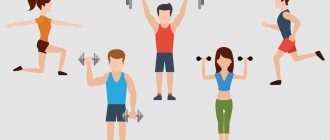First, let's figure out why we actually burn calories when we walk. No, it's not about speed or stride length! When you take the first step, you transfer your body weight to your forward leg. At the same time, the height of your center of gravity from the ground decreases - naturally, because your legs are apart, which means that the distance in a straight line upward becomes smaller. When you step with your other foot, you have to raise your center of gravity (at the moment when your feet are together). And this is where the main consumption of calories occurs - to overcome the force of gravity! Yes, yes, everything is the same as lifting a barbell, only you lift your own body. This is the moment when calories are consumed, the main energy of the step is spent on this.
How to calculate calorie consumption when walking?
As we explained above, your calorie consumption per kilometer depends on how many kilograms you lift with each step (that is, your body weight and height). Calorie consumption per kilometer does not depend on speed as such. However, energy consumption per minute or hour is directly related to speed. After all, at a higher speed, you will take more steps per minute and cover that same kilometer faster.
To calculate energy expenditure when walking, the following formula is usually used:
Energy consumption in kcal in 1 minute = (0.035 * your body weight) + (walking speed * 2 / your height) * 0.029 * your body weight
To get the cost per workout, all this must be multiplied by the walking time.
To avoid complex calculations, you can use a simplified option: every 2000 steps = 100 kcal .
The effectiveness of classical walking for losing excess weight
The classic type of walking includes:
- Walking with your child in the park;
- Walking long distances to your destination (for example, going to work in the morning instead of traveling by public transport and returning home);
- Hiking;
- Walking a pet.
By walking during the day, a person also expends calories, as when working out in the gym, but does not subject the body to severe physical stress.
The number of calories burned while walking is influenced by the following factors:
- Walking duration;
- Human weight and height;
- Length of lower limbs;
- Individual characteristics of metabolism;
- Length of the route traveled;
- Times of Day;
- The person’s age and gender;
- General health;
- Walking pace;
- Frequency of rest breaks.
Number of calories burned in 1 hour of walking
Experts calculate calorie expenditure per hour of walking, focusing on a person’s weight, walking pace and distance.
For every kilogram of weight a person spends per hour:
- The average walking pace at a speed of 4 km is 3.2 cal;
- Accelerated walking pace at a speed of 6 km – 3.5 cal;
- Fast walking pace (almost running) at a speed of 8 km – 10 cal.
A person with a body weight of 80 kilograms will spend 0.28 kilocalories in an hour of accelerated walking. For comparison:
- 1 hour of intense step aerobics – 0.56 kcal;
- 1 hour of active exercise on an exercise bike – up to 0.8 kcal;
- 1 hour of dynamic yoga (ashtanga) – up to 0.42 kcal;
- 1 hour crawl style swimming - up to 0.6 kcal.
Some will find that other physical exercises give better results than walking, because the number of calories burned in their case is two or even three times greater. This is partly true. Professional athletes say that exercise on an exercise bike or step aerobics burns excess weight faster, but they also require physical training. If a person is heavy and has never visited the gym or done regular exercise at home, then walking is the best solution for him.
With its help, those who want to lose weight, but are not prepared for intense exercise:
- Strengthens the muscles of the lower body and back;
- Makes the body resilient;
- Improves metabolism;
- Lose some weight to make it easier to train in the future.
Afterwards, you can alternate between walking and visiting a fitness club or exercising at home with sports equipment.
How many calories are consumed per 1 km walk?
The number of calories burned per 1 kilometer of walking depends on how fast a person moves. Weighing 80 kilograms, someone who walks 1 km at an accelerated pace spends up to 330 calories. Slow (simple walk) – up to 200 cal, on average – up to 260 cal.
To know how many calories are burned while walking, you need to buy a fitness bracelet. It has an accelerometer that accurately determines the speed of movement. The results of the walk can be viewed in the mobile application, which is synchronized with the bracelet.
Taking into account the individual characteristics of the body and other factors, the indicators may change up or down by about 40 calories. The more mobile and healthy a person is, the faster he will lose excess weight when walking, and vice versa.
To correctly calculate the calorie expenditure per 1 kilometer of travel, you need to consult a fitness trainer. He will assess his physical condition, take into account all the characteristics of a particular person’s body and tell him how much and at what pace he needs to walk in order to burn off extra calories and lose weight without harm to health.
How many calories are burned by walking every day?
We all walk for a certain amount of time and at different speeds. Without counting the number of steps, energy consumption cannot be determined, so you need to use at least a basic pedometer, smartphone application or fitness bracelet. Smart devices can count calories themselves. Or use our table.
| 1000 steps | 50 kcal |
| 4000 steps | 200 kcal |
| 5000 steps | 250 kcal |
| 7000 steps | 350 kcal |
| 8000 steps | 400 kcal |
| 9000 steps | 450 kcal |
| 10000 steps | 500 kcal |
| 15000 steps | 750 kcal |
Of course, all this is somewhat arbitrary. After all, the height to which you lift your weight while walking also depends on how you walk: on a treadmill, along the street, up a hill. The surface and direction change the length of the step, respectively, its frequency, and the degree of bending of the legs.
Rock climbing
It's one thing to walk on the ground, and quite another to climb up a mountain (or a sheer wall). Try it - if it works, you will burn almost 120 kcal in 10 minutes. And, of course, after this exercise you will understand what excess weight is.
♥ ON THE TOPIC: Donald Trump in the movies: Home Alone 2 and other films, TV series and videos in which the former US president starred.
How many calories are spent walking in different conditions?
The easiest option is a treadmill. Since it rotates under you, you can hardly move your leg forward, which means you can minimally lower and raise your center of gravity.
“You will burn more calories if you walk outside,” says candidate master of sports PRO-expert Sportmaster PRO Daniil Lobakin. — On a treadmill there is no pushing force of the foot from the surface, due to which you can also burn calories. Additional load on the street can be caused by uneven terrain - rises. Nordic walking is more effective than regular walking because it works the arms and shoulder girdle. Due to the fact that while walking you also work with poles, you make more movements. During normal walking there is no such additional energy expenditure.”
Jump rope
Even if you are a terribly lazy person and don’t want to go anywhere to study, you also have a chance! Just buy a jump rope and jump! Of course, few people will be able to complete all 10 minutes - so to start, work for 40 seconds and rest for 20, and then gradually increase the time. The result is 107 kcal in 10 minutes!
♥ ON TOPIC: How the brain distinguishes the beautiful from the ugly.
How many calories does walking 1.5 km or 10 km burn?
As we have already explained, it all depends on your weight and number of steps. Typically, the step length is 50-70 cm (the taller the person, the longer the step will be). Thus, you will definitely burn 100 kcal per 1 km.
The 1 km distance is good because it can be found everywhere - on the way to school, work, or when going to the grocery store. That is, you can go through it several times a day without particularly noticing or getting tired.
The 5 km distance requires at least an hour of walking and a fairly brisk pace. After all, the average pedestrian speed is only 3-4 km/h. On average, such a walk will burn about 400 kcal.
Walking 10 km in one go is possible for well-physically trained people. At an average walking pace, you will spend about 3 hours on it and may feel quite exhausted. The result is up to 800 kcal, after which every muscle will be felt!
How fast and how long should you walk to lose weight?
Note that a leisurely walk in the park will not give you enough exercise to increase calorie burning. You need to walk quickly, although, of course, not as quickly as sports walkers rush.
Active burning of calories begins not from the fact that you make any movements, but from an increase in heart rate. For most people, brisk walking starts at 5 km/h (12 min/km). When walking 7 km/h (08:34 min/km) you will burn the same number of calories as when running at the same pace, but even a beginner can run at this pace, but not even an experienced runner can walk.
Trainers recommend varying your walking pace, just as we do during running workouts. Walk at a fast, uncomfortable pace for two minutes, then slow down to a comfortable pace. Repeat as many times as you like. In addition to actively burning calories, it will improve your aerobic fitness. Your heart rate should rise to at least 100 beats at an accelerated pace.
If you run in addition to walking, an hour of brisk walking is enough to increase your daily calorie expenditure. Thus, in Kenneth Cooper’s work “The New Aerobics: A System of Health-improving Physical Exercises for All Ages,” it is said that to achieve satisfactory fitness, you need to walk 6.5 km at an accelerated pace. In general, this is enough for an hour's walk.
So, let’s summarize the effect of walking on weight loss:
- Running burns more calories than walking, but maintaining a high intensity for a long time is more difficult.
- Due to the lower intensity of walking, a higher percentage of calories burned comes from fat burning, but there is no afterburn effect.
- Both walking and running burn enough calories to help you lose weight, but only if you make the necessary changes to your diet at the same time.
How to increase calorie expenditure while walking?
The easiest option is to walk more or faster to increase your step count. But there is another burden.
“You can hang weights on your legs or take a backpack with them,” suggests Daniil Lobakin. “Any weight gain will make exercise more difficult and create the conditions for greater caloric energy expenditure.” With weights, everything is individual. If a muscular man weighing about 90 kg is going to train, you can even choose two-kilogram weights. Girls are better off starting with 0.5 kg.
Also consider how long you will be walking with weights and where. “If you go uphill, half a kilo will be enough,” says Daniil Lobakin. - There are smaller weights - 250 g. If you walk on the plain for about half an hour, you can use kilogram ones. Everything here is very individual.” When choosing a weight, we need to take into account that we will not be walking for 2-3 minutes; according to experience, the average walking time is an hour and a half. There is no upper limit, since this is not an intense run, you can even walk all day, focusing on how you feel.
What are the benefits of walking?
It would seem that such a common type of activity surrounds us every day. We have to take thousands of steps, but during this the body works:
- heart function improves;
- cells are more actively saturated with oxygen;
- the calf muscles, pelvis, thighs are trained;
- immune activity increases.
The main benefit of walking is weight loss. It may be insignificant, but with increasing intensity and adding loads, this type of activity is equivalent to visiting the gym or running fast. A walk in the park after work at a pace is a great opportunity not only to lose weight, but also to unload your head after work, take your mind off your thoughts and spend time with pleasure.
[yuzo_related]
Correct walking technique
To maximize the benefits of walking, watch your body position.
- Maintain correct posture: do not lower your head, look 5-10 m ahead, do not slouch.
- Bend your elbows, as if running, and use them to set the amplitude of your step.
- Tighten your abdominal muscles, tighten your buttocks slightly.
- Walk, rolling your feet from heel to toe.
- Lightly emphasize the toe-off of the ground in the last phase of the step using the ankle joint.
Sometimes beginners try to master the technique of race walking. “Race walking is a rather technically complex sport, and it is not easy to master,” explains Daniil Lobakin. - World record - an athlete walked 21 kilometers in 1 hour 28 minutes, I run this distance slower. If you want to take up race walking, it is better to work with a trainer. The main subtlety of the race walking technique is that the arms must work together with the legs. People often get confused during training. In addition, race walking should not switch to running - in running there is a flight phase, and here there must be a constant point of support.”
Do your styling
Energy consumption:
100 kcal / 45 minutes.
Let's not hide the fact that when faced with a choice - blow dry your hair or sleep an extra 30 minutes - many ladies will prefer the latter. However, if you want to eat chocolate at lunch without harming your figure, still add the procedure to your schedule. Due to the static load, you will burn 100 kcal, and by laying down every other day, you can make your arms more prominent. Keeping them suspended for half an hour is not an easy task. As a nice bonus, you will receive a beautiful hairstyle.
Egor:
During styling, the deltoid muscles of the shoulder, trapezius muscles and neck muscles work. Plus, if something goes wrong, you can also lose a few grams due to stress.
How to walk correctly for health and weight loss?
Walking is available for many health restrictions, so it is not surprising that it is so popular among fans of a healthy lifestyle.
“Walking is usually done for weight loss and cardiovascular training,” says Daniil Lobakin. — Beginners and people with excess weight and age walk just in the right pulse zone, about 130-145 beats per minute. The main thing in walking is the work of the hands, especially if a person walks with Scandinavian poles. The left leg goes - the right hand goes, alternating, you need to focus on this.”
If you decide to try Nordic walking, the main thing is to use poles specifically for it, and not for trekking. They are very similar, but trekking poles have a different grip, which interferes with Nordic walking.
And, of course, don’t forget about proper nutrition and calorie restriction - without this you won’t be able to lose weight even with the most intense workouts. Good walk!
Play a dance show and repeat after the participants
Energy consumption:
100 kcal / 10 minutes.
Dancing is an excellent cardio workout that works different muscle groups at the same time. Such activity has a positive effect not only on a person’s health, but also on his mood. 10 minutes of intense exercise in front of the TV can burn 100 calories. Want more? Not a problem - as a rule, such programs last about two hours. Don’t worry if suddenly you don’t know how to dance - no one will see you at home.
From aerobics to aerial yoga: how the fashion for training has changed
“Tighten” your muscles: how does pole dancing affect your figure?
Exercise bike
During training on an exercise bike, your legs swing and your back strengthens, making your posture straight and your gait easy. Ten minutes on an exercise bike is enough to burn about 100 calories. Just alternate between normal driving and fast sprinting. You need to breathe evenly through your nose. An alternative to such training is cycling.
By exercising on an exercise bike, you can lose a few extra pounds and pump up your muscles.
Games with children or pets
Children and pets are excellent helpers in the fight against excess weight. They are very active and always enjoy playing outdoor games, so you just need to join them. In 15 minutes of such active rest you can burn at least 100 calories. This activity also helps to lift your spirits and strengthen your bond with your children.
Children are great helpers when it comes to losing weight.
Jumping
No equipment is needed here at all. T.N. Plyometric exercises involve explosive, fast movements to develop muscle mass and speed. One of the main exercises is the depth jump.
♥ ON TOPIC: Pedometer for iPhone, or how to count steps, distance and calories without buying accessories and applications.
Gardening
Gardening enthusiasts can save a lot of money on a gym thanks to their hobby. Weeding, digging, or planting for 25 minutes can permanently burn up to 100 calories. This is not only a good workout, but also a great opportunity to improve the area near your home and grow organic vegetables and fruits, while breathing fresh air.
Weeding, digging, planting and other gardening activities burn up to 100 calories in 25 minutes
Exercises with dumbbells
Training with dumbbells helps you burn about a hundred calories in just 10 minutes of training. A very effective exercise is the lunge with dumbbells. To perform it, you need to take two dumbbells and stand straight, placing your arms along your body. Take a step with your left foot and perform a squat. The shin of the right leg should be parallel to the floor, and the knee should form a right angle. Hold this position for one second and return to the starting position. Repeat the exercise with the other leg. For 10 minutes, you need to alternate 10-12 repetitions with short rests between sets. And remember that while squatting, you need to inhale, and when lifting, exhale.
Even the simplest weight-bearing exercises can burn about 100 calories in just 10 minutes.
Step aerobics
Step aerobics is a cardio workout based on simple movements on a special platform. It only takes 10 minutes to burn 107 calories. While performing the exercises, your legs should be slightly bent, your back straight, your stomach pulled in, and your buttocks tense. To begin, simply step onto the platform with two feet at a time and return to the starting position. Next, take steps with overlap and moving your legs back. And at an advanced level, start jumping on and over platforms.
Step aerobics is intense exercise using a step stand.
Boxing
10 minutes of working with a punching bag will burn the same 107 kcal forever. If your form allows, take weighted gloves, hit the bag for 22 minutes - and say goodbye to 300 calories right away.
♥ ON TOPIC: What happens if you drink only water as a liquid for 30 days.










